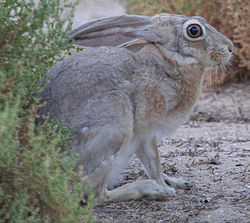Hare
A hare (Lepus), also known as a jackrabbit, is a mammal of the order Lagomorpha, in the same family as the rabbit. They are larger than rabbits and have black tipped ears. Their diet (the food they eat) resembles what rabbits eat; they eat ruttabaga and lettuce. They graze on grass and leafy weeds.
| Lepus timidus (European hare) | |
|---|---|

| |
| Young Hare, a watercolour by the master Albrecht Dürer, 1512 | |
| Scientific classification | |
| Kingdom: | |
| Class: | |
| Order: | |
| Family: | |
| Genus: | Lepus Linnaeus, 1758
|

Hares are very fast-running animals. The European brown hare (Lepus europaeus) runs at speeds up to 56 km/h (35 mph).[1][2] The five species of hare found in central and western North America can run at 64 km/h (40 mph), and can leap up to 3m (ten feet) at a time.[3] They live solitarily or in pairs; "a drove" is the name for a group of hares.
Mating season
Normally a shy animal, they change their behaviour in spring, when hares chase one another around meadows. This may be competition between males to attain dominance (and hence more access to breeding females).[4] During this spring frenzy, hares can be seen "boxing"; one hare striking another with its paws (probably the origin of the term "mad as a March hare"). For a long time, this was thought to be intermale competition, but closer observation has shown it is usually a female hitting a male to prevent copulation.[5][6] When a doe is ready to mate, she runs across the countryside, starting a chase that tests the stamina of the following males. When only the fittest male remains, the female stops and allows him to copulate.[7]
Snowshoe hare
This is a species of hare found in cold climates in North America. As with the Arctic fox, its hair is white in winter, and brown in the summer. These are different morphs. This ability gives it camouflage, which it needs because it is the favourite food of the Canadian lynx.[8]
Hare Media
European hare (above) and mountain hare
Alaskan hare's skeletal system (Museum of Osteology)
Dreihasenfenster (Window of Three Hares) in Paderborn Cathedral
References
- ↑ McKay, George; McGhee, Karen (2006). National Geographic encyclopedia of animals. National Geographic Books. p. 68. ISBN 9780792259367.
- ↑ Vu, Alan. "Lepus europaeus: European hare". Animal diversity web. University of Michigan Museum of Zoology. Retrieved 9 January 2013.
- ↑ USA (11 April 2010). "Jackrabbits, jackrabbit pictures, jackrabbit facts - National Geographic". Animals.nationalgeographic.com. Archived from the original on 2010-02-07. Retrieved 2013-01-12.
- ↑ Bray Y.; et al. (2007). "Natal dispersal of European hare in France" (PDF). Journal of Zoology. 273 (4): 426–434. doi:10.1111/j.1469-7998.2007.00348.x. Archived from the original (PDF) on 2016-10-06. Retrieved 2018-05-05.
- ↑ Naughton, D. 2012. The natural history of Canadian mammals. University of Toronto Press. pp. 235–238. ISBN 1-4426-4483-4
- ↑ Holley, A.J.F.; Greenwood, P.J. (1984). "The myth of the mad March hare". Nature. 309 (5968): 549–550. Bibcode:1984Natur.309..549H. doi:10.1038/309549a0. PMID 6539424. S2CID 4275486.
- ↑ Holly T. 2001. Mad world of the European hare. In MacDonald D. The new encyclopedia of mammals. Oxford University Press. pp. 710–711. ISBN 0-19-850823-9
- ↑ Krebs C. & and Myers J. 2015. The snowshoe hare 10-year cycle – a cautionary tale. [1]






